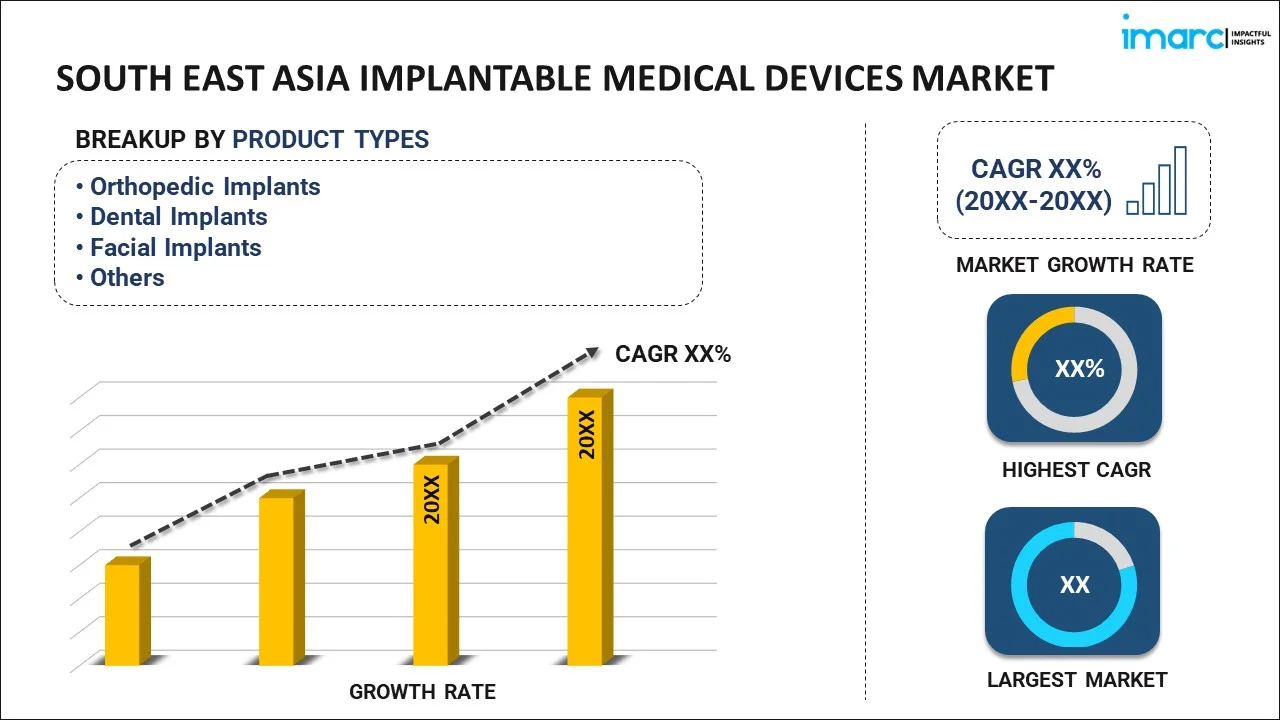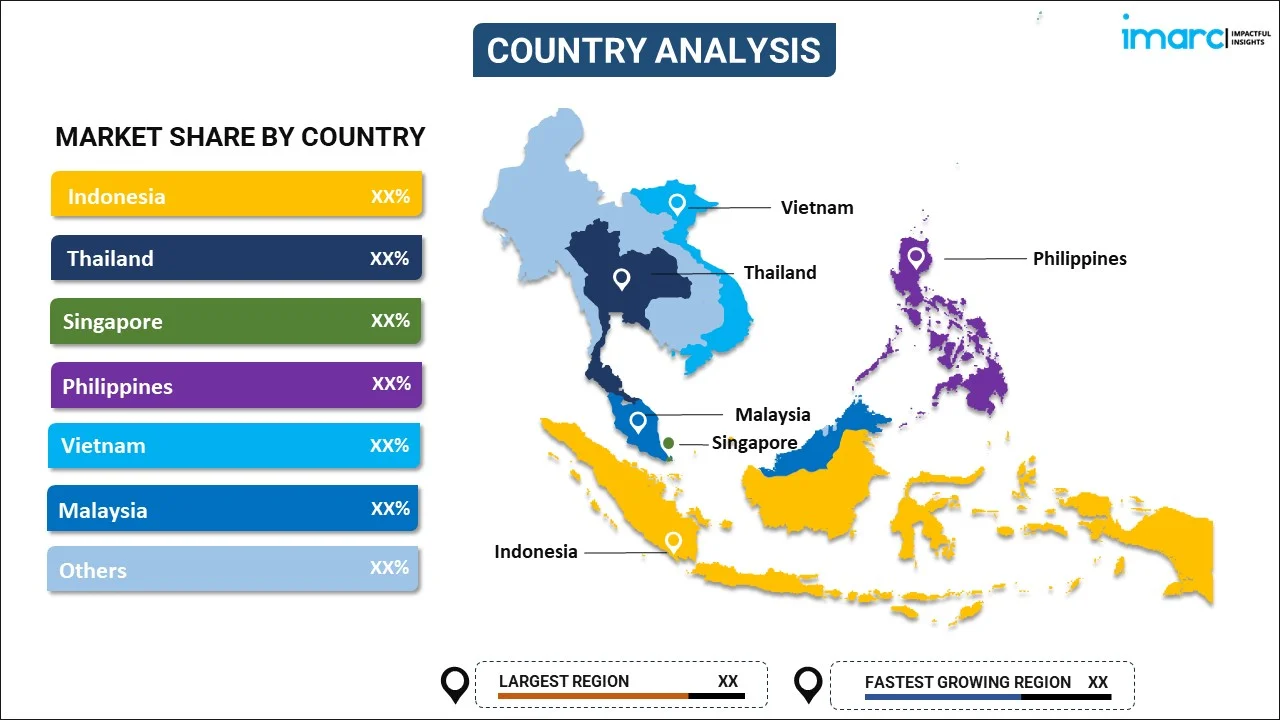
South East Asia Implantable Medical Devices Market Report by Product Type (Orthopedic Implants, Dental Implants, Facial Implants, Breast Implants, Cardiovascular Implants, and Others), Material (Polymers, Metals, Ceramics, Biologics), End User (Hospitals, Ambulatory Surgery Centers (ASCs), Clinics), and Country 2024-2032
Market Overview:
South East Asia implantable medical devices market size is projected to exhibit a growth rate (CAGR) of 8.45% during 2024-2032. The growing focus on preventive healthcare measures, improved healthcare infrastructure facilities, and increasing need to address age-related health issues, such as joint replacements and cardiovascular conditions, represent some of the key factors driving the market.
|
Report Attribute
|
Key Statistics
|
|---|---|
|
Base Year
|
2023 |
|
Forecast Years
|
2024-2032
|
|
Historical Years
|
2018-2023
|
| Market Growth Rate (2024-2032) | 8.45% |
Implantable medical devices (IMDs) are used to be placed inside the body to monitor, support, or replace certain bodily functions. They are available in various forms, such as pacemakers, cochlear implants, intraocular lenses (IOLs), defibrillators, insulin pumps, and artificial joints. They are manufactured from biocompatible materials to ensure compatibility with the human body and minimize the risk of adverse reactions or complications. They can be customized as per the specific needs of individual patients. They are surgically implanted within the body of the patient, offering long-term benefits and an improved quality of life while reducing the need for frequent medical interventions. They are designed to deliver specific treatments or therapies to patients with different diseases. They serve various purposes, including monitoring, supporting, or replacing specific bodily functions or treating medical conditions. They allow individuals with diabetes to manage their condition more independently. They help prevent heart failure exacerbations by monitoring and adjusting treatment based on real-time data. Besides this, they are beneficial in alleviating symptoms, reducing pain, and restoring lost functions. As they assist in providing immediate emergency care to individuals, the demand for IMDs is increasing in South East Asia.
South East Asia Implantable Medical Devices Market Trends:
At present, the rising adoption of advanced IMDs, as they offer continuous monitoring and data collection and allow healthcare providers to track health conditions of a patient remotely, represents one of the primary factors contributing to the growth of the market in South East Asia. In line with this, the growing demand for IMDs to address age-related health issues, such as joint replacements and cardiovascular conditions, is offering a positive market outlook. Moreover, the increasing adoption of implantable solutions, as they offer quicker recovery times and reduced post-operative pain, is bolstering the market growth. Apart from this, there is a rise in the demand for IMDs that are manufactured from eco-friendly materials. This, coupled with the increasing prevalence of chronic diseases like diabetes and heart diseases, among the masses is supporting the market growth. Additionally, technological advancements in medical technology assist in the development of more advanced and durable IMDs for enhanced reliability, which is strengthening the market growth. Besides this, the escalating demand for IMDs on account of improved healthcare infrastructure facilities is positively influencing the market in South East Asia. Furthermore, the rising focus on preventive healthcare measures is offering lucrative growth opportunities to industry investors. In addition, the increasing health insurance coverage in South East Asia makes IMDs more accessible to a broader range of patients, which is propelling the market growth.
South East Asia Implantable Medical Devices Market Segmentation:
IMARC Group provides an analysis of the key trends in each segment of the market, along with forecasts at the regional and country level for 2024-2032. Our report has categorized the market based on product type, material, and end user.
Product Type Insights:

- Orthopedic Implants
- Dental Implants
- Facial Implants
- Breast Implants
- Cardiovascular Implants
- Others
The report has provided a detailed breakup and analysis of the market based on the product type. This includes orthopedic implants, dental implants, facial implants, breast implants, cardiovascular implants, and others.
Material Insights:
- Polymers
- Metals
- Ceramics
- Biologics
A detailed breakup and analysis of the market based on the material have also been provided in the report. This includes polymers, metals, ceramics, and biologics.
End User Insights:
- Hospitals
- Ambulatory Surgery Centers (ASCs)
- Clinics
The report has provided a detailed breakup and analysis of the market based on the end user. This includes hospitals, ambulatory surgery centers (ASCs), and clinics.
Country Insights:

- Indonesia
- Thailand
- Singapore
- Philippines
- Vietnam
- Malaysia
- Others
The report has also provided a comprehensive analysis of all the major regional markets, which include Indonesia, Thailand, Singapore, Philippines, Vietnam, Malaysia, and Others.
Competitive Landscape:
The market research report has also provided a comprehensive analysis of the competitive landscape in the market. Competitive analysis such as market structure, key player positioning, top winning strategies, competitive dashboard, and company evaluation quadrant has been covered in the report. Also, detailed profiles of all major companies have been provided.
South East Asia Implantable Medical Devices Market Report Coverage:
| Report Features | Details |
|---|---|
| Base Year of the Analysis | 2023 |
| Historical Period | 2018-2023 |
| Forecast Period | 2024-2032 |
| Units | US$ Million |
| Scope of the Report | Exploration of Historical and Forecast Trends, Industry Catalysts and Challenges, Segment-Wise Historical and Predictive Market Assessment:
|
| Product Types Covered | Orthopedic Implants, Dental Implants, Facial Implants, Breast Implants, Cardiovascular Implants, Others |
| Materials Covered | Polymers, Metals, Ceramics, Biologics |
| End Users Covered | Hospitals, Ambulatory Surgery Centers (ASCs), Clinics |
| Countries Covered | Indonesia, Thailand, Singapore, Philippines, Vietnam, Malaysia, Others |
| Customization Scope | 10% Free Customization |
| Report Price and Purchase Option | Single User License: US$ 3699 Five User License: US$ 4699 Corporate License: US$ 5699 |
| Post-Sale Analyst Support | 10-12 Weeks |
| Delivery Format | PDF and Excel through Email (We can also provide the editable version of the report in PPT/Word format on special request) |
Key Questions Answered in This Report:
- How has the South East Asia implantable medical devices market performed so far and how will it perform in the coming years?
- What has been the impact of COVID-19 on the South East Asia implantable medical devices market?
- What is the breakup of the South East Asia implantable medical devices market on the basis of product type?
- What is the breakup of the South East Asia implantable medical devices market on the basis of material?
- What is the breakup of the South East Asia implantable medical devices market on the basis of end user?
- What are the various stages in the value chain of the South East Asia implantable medical devices market?
- What are the key driving factors and challenges in the South East Asia implantable medical devices?
- What is the structure of the South East Asia implantable medical devices market and who are the key players?
- What is the degree of competition in the South East Asia implantable medical devices market?
Key Benefits for Stakeholders:
- IMARC’s industry report offers a comprehensive quantitative analysis of various market segments, historical and current market trends, market forecasts, and dynamics of the South East Asia implantable medical devices market from 2018-2032.
- The research report provides the latest information on the market drivers, challenges, and opportunities in the South East Asia implantable medical devices market.
- Porter's five forces analysis assist stakeholders in assessing the impact of new entrants, competitive rivalry, supplier power, buyer power, and the threat of substitution. It helps stakeholders to analyze the level of competition within the South East Asia implantable medical devices industry and its attractiveness.
- Competitive landscape allows stakeholders to understand their competitive environment and provides an insight into the current positions of key players in the market.
Need more help?
- Speak to our experienced analysts for insights on the current market scenarios.
- Include additional segments and countries to customize the report as per your requirement.
- Gain an unparalleled competitive advantage in your domain by understanding how to utilize the report and positively impacting your operations and revenue.
- For further assistance, please connect with our analysts.
 Inquire Before Buying
Inquire Before Buying
 Speak to an Analyst
Speak to an Analyst
 Request Brochure
Request Brochure
 Request Customization
Request Customization




.webp)




.webp)












